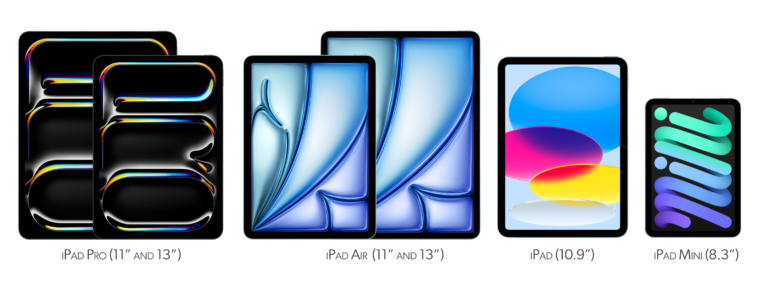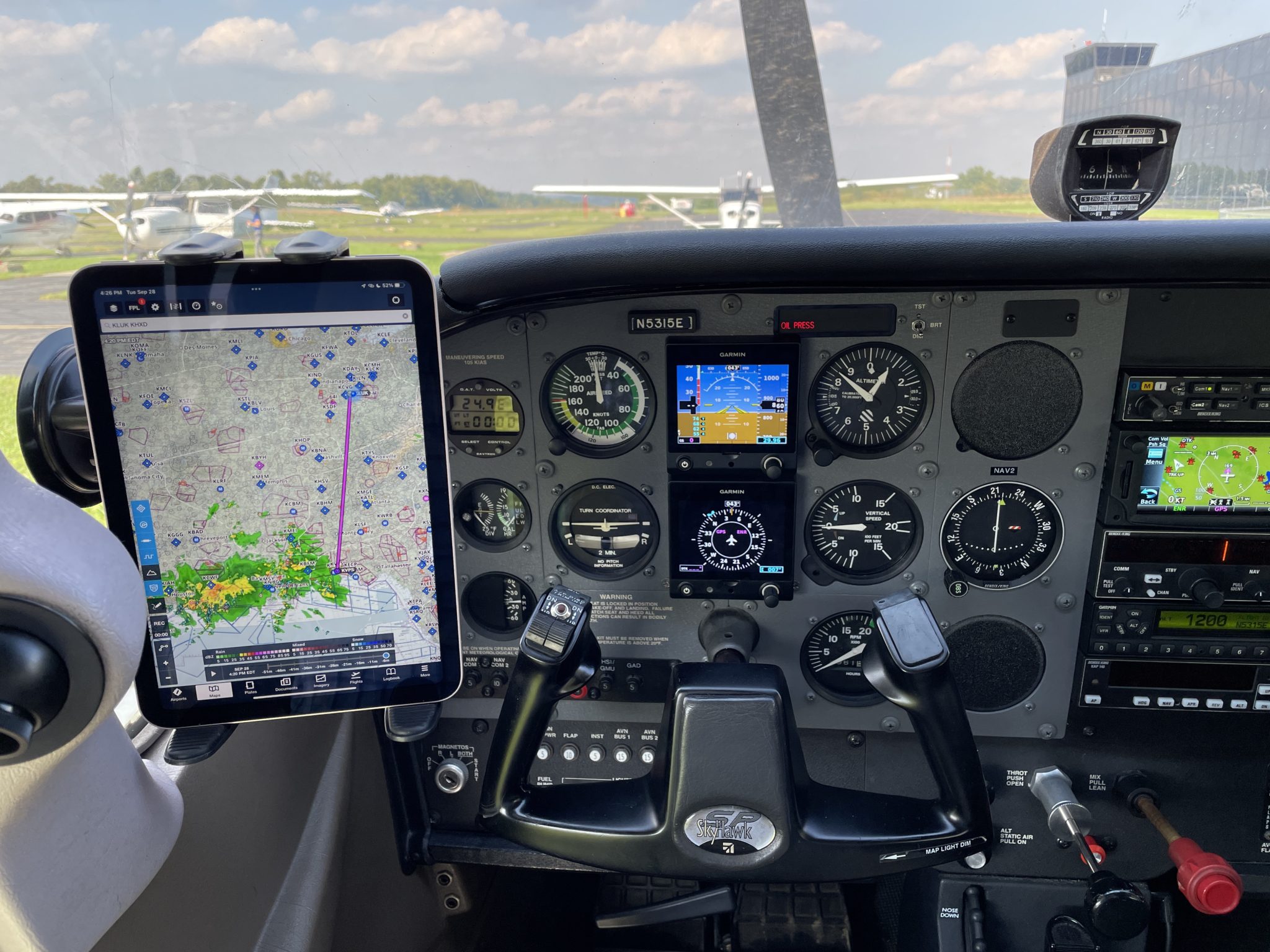
What’s the best iPad for Pilots – 2024 Edition
iPad Pilot News
The original Apple iPad was released more than 14 years ago on April 3, 2010. Since then Apple has continuously improved the tablet, making upgrades to its storage capacity, screen resolution, processor, connectivity options and form factor. The iPad Pro 11″ and 13″ are the top-end models currently available for sale today, and represent an enormous leap in performance over the original iPad.
While these high-performance pro models would suit (and honestly exceed) most pilots’ needs in the cockpit, there are some other options and features worth considering when purchasing an iPad for use in aviation. Here we’ll break down the differences in each, and give some insight for those looking to buy a used or refurbished iPad, which is a great way to save some money.
iPad Pro, iPad Air or iPad Mini?
Apple currently offers 4 models of iPad: the iPad Mini (8″), the iPad (10.9″), the iPad Air (11 and 13″), the iPad Pro (11″ and 13″). The iPad (good), iPad Air (better) and the iPad Pro 11″ (best) feature nearly the same external dimensions and pilots will find that all three work very well with nearly every aviation app available.
The 10.9” and 11” specs on the mid-size models refer to the screen’s diagonal dimension, meaning these models feature more screen real estate than the original iPad while maintaining a similar form factor.
The flagship iPad Pro 11″ includes a large edge-to-edge display, a high-performance multicore processor, and along with the iPad Pro 13″, is the only iPad to use FaceID for unlocking. It includes a bright, high-resolution OLED screen with an anti-reflective coating. It’s also the only model that offers an optional nano-texture coating on the screen, which significantly reduces glare in the cockpit (read our PIREP on that technology here).
The larger iPad Air and Pro 13″ models represent a significant improvement over the original iPad Pro 13″ – they are 25% smaller while retaining the same display size, thanks to the edge-to-edge screen. The footprint is about the same as a sheet of paper, so it can fit in most GA cockpits if you want the largest screen available, but don’t try to fly with it in your J-3 Cub.
Apple released updated iPad Pro 11″ and 13″ models in May 2024. While the form factor remains similar, the 2024 models were upgraded with an OLED screen and include Apple’s M4 processor, which Apple claims to be 50% faster than the M2 it replaces.
Apple also refreshed the iPad Air model in May 2024 and it looks a lot like the iPad Pro with an edge-to-edge screen, no home button, and USB-C for charging. It uses the powerful M2 processor which can handle the most demanding aviation app demands with ease. For security, the iPad Air incorporates TouchID in the power button at the top of the device, which some pilots find to be more reliable than FaceID in the cockpit.
The entry-level model referred to as just “iPad” was last updated on October 2022 and on the surface looks very similar to the iPad Air. It incorporates Apple’s A14 processor, which has plenty of power to run any of today’s aviation apps effortlessly. It includes Touch ID in the top power button and uses USB-C for charging. One difference worth noting between the iPad Air and iPad is that the screen on the entry-level iPad does not include the anti-reflective coating, which is a nice feature in bright cockpits.
If you’re looking for an iPad with a smaller footprint, consider the iPad mini. This version measures 7.69″ by 5.3″ and will be a better fit in cockpits with tighter constraints. The latest 6th generation model was last updated in September 2021, uses the A15 Bionic processor and includes the anti-reflective screen coating (read our PIREP on this model here). For a sense of the size, here’s a picture of an iPad Mini 6 in a Cessna 172 cockpit:
WiFi-only or WiFi + Cellular model (and GPS)?
After choosing a size, it’s on to the connectivity question. This is pretty simple, but there are some confusing terms thrown around, so let’s start basic.
Every iPad model ever built offers WiFi connectivity to the internet, so you can connect to your home network, your office network, a local coffee shop, etc. But you can also buy an upgraded cellular model that receives wireless data from a carrier like AT&T or Verizon (for a monthly fee).
The benefit to pilots with the cellular model is that it also contains an internal GPS receiver, which is useful for showing your aircraft’s position on aviation map applications (although it has some minor limitations). The cellular model also allows you to download weather and file flight plans on the go, but don’t count on this cellular data connection to work in the air. In our experience, it just isn’t reliable. It’s also technically illegal. Again, only the cellular model iPads have a built-in GPS.
The internal GPS on an iPad with cellular data is completely independent of the cellular antenna and does not require that you activate a data plan from AT&T or Verizon to work properly. You could buy a cellular model iPad and use the GPS without ever activating your service.
So, which is the right choice for pilots? Either one, really. Many pilots already fly with an ADS-B receiver that includes an integrated GPS, so you can save some money on your iPad purchase and rely on your ADS-B receiver for a position source. Others prefer to have the integrated GPS in the iPad as an always-on backup and consider the upgrade to be cheap insurance. The GPS found in today’s cellular iPad model is much improved over the GPS receivers found in the original iPad models, so it is fast and accurate (read our iPad GPS PIREP here). From the connectivity side, if you frequently use your iPad on the ground at locations without WiFi, the upgrade to the cellular model definitely makes sense.
Storage capacity
The base storage capacity varies by model and each offers the option to go bigger: 64 GB for the iPad Mini and iPad, 128 GB for the iPad Air and 256 GB for the iPad Pro. The Pro models offer the most storage, with the option to upgrade up to 2TB. Downloading all the VFR and IFR charts for the entire United States across multiple data cycles can take nearly 20GB, so even the smallest option available can work but it quickly gets tight if you limit yourself to 64 GB on the entry-level models. You have to consider that you might also want to store high-resolution terrain data, synthetic vision, charts for Canada, Mexico and Caribbean, and PDF documents.
Another thing to keep in mind is that many apps like ForeFlight allow you to download the next cycle’s charts approximately four days in advance. If you plan to keep charts for the entire U.S. on your iPad, you’ll need additional free space during this transition period each month.
Finally, consider that you may use the iPad for more than just aviation (e.g., pictures, videos, other apps), so you’ll want to leave open some free space for those items. The iPad’s memory is not upgradeable, so you have to commit to a size up front. If in doubt and you plan to use your iPad beyond just the cockpit, consider 128 GB as the bare minimum. That may sound like a lot now, but it doesn’t leave much room for future growth as new aviation databases and features are introduced and your photo and music libraries continue to expand.
Conclusion

Most of the pilots we talk to prefer the smaller size of the iPad Mini in Cessna and Piper airplanes.
The good news is that any iPad model will work for pilots, so there’s not a bad choice here. But some are definitely better than others. So, which model do we recommend?
Based on our experience talking with pilots flying GA piston airplanes, the iPad mini 6 is by far the most popular choice, primarily because of how well it fits in most cockpits while maintaining a bright screen. For this reason, our first choice would be the iPad Mini 6 with 256GB model as the best iPad for aviation (most popular).
We hear from many pilots too who prefer the larger screen size of iPad and iPad Air for improved readability in the cockpit. If this size sounds like the right fit for you, we recommend the iPad Air with 128GB of storage.
The iPad iPad Pro models work great in the cockpit too, but it’s hard to justify the higher price unless you have a need for graphic-intensive applications or multitasking performance when away from the airplane (or really need optional nano-texture screen coating for sunlight readability).
The one exception on the iPad Pro models is if you’re looking for the ultimate big-screen experience on the flight deck. If this sounds like you, check out the 13″ iPad Air or Pro. It’s not cheap, but for those who like the big display and had previously tried to shoehorn the original 13″ model in the cockpit, this model is worth another look. It can do double duty as a laptop replacement too.
We’ve found the reliability and performance of external GPS receivers to be just as good as the iPad’s internal GPS option, and they’re available for under $150. However, if you’re willing to spend a little more, the GPS included with the iPad with cellular data is more convenient to use and very accurate. For the ultimate setup, we recommend adding a wireless ADS-B receiver, like Sentry ADS-B receiver, which provides subscription-free in-flight weather and WAAS GPS position data.
Lastly, keep an eye on Apple’s refurbished iPad offerings. They will look brand new to you out of the box, and include a new internal battery and the same warranty as a new iPad. It’s a great way to save $100 or more on a higher-end model.
The post What’s the best iPad for Pilots – 2024 Edition first appeared on iPad Pilot News.
The post What’s the best iPad for Pilots – 2024 Edition appeared first on iPad Pilot News.
Source: Ipad appsWhat’s the best iPad for Pilots – 2024 Edition




